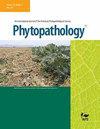黑螺旋体致病性遗传研究。
摘要
亚麻锈病真菌Melampsora lini (Pers.)列弗。,雌雄同株,长周期;也就是说,它只在一种亚麻上产生它的初、中期、中期和终末阶段。Allen(1)证明了M. lini的异源性,Flor(3,4)发现栽培亚麻(Linum usitatissimum L.)的锈病由许多生理小种组成。每一个被测试的亚麻品种都对从北美和南美收集的亚麻锈病中鉴定出的24个生理小种中的一个或多个敏感。然而,没有一个已知的品种能够攻击这些试验中使用的所有11个差异品种。在美国北部,亚麻锈病通过病菌越冬(6),因此,每年的自然杂交可能与感染的开始一致。要想培育出理想的抗锈亚麻品种,不仅需要了解控制亚麻品种锈病反应的因素之间的相互作用,还需要了解不同种类的亚麻锈病真菌致病性因素之间的相互作用。本文所报告的数据涉及后一个问题。对锈病致病性遗传的认识是有限的。直到1927年,Craigie(2)才证明了锈病的异源性,从而使对这些有机体的遗传研究成为可能。锈病的生理小种是通过在一系列差异品种上产生的感染类型来区分的,这是一个艰苦的过程,限制了可以研究的后代培养的数量。对锈病致病性的遗传研究的其他障碍是菌株的反复萌发和获得已知纯合性的小种的困难。也有可能用于鉴定生理小种的差异品种不能将锈病分解为所有的基因型菌株。通过对已知小麦锈病小种的自交或杂交,获得了新的小麦锈病生理小种。,嗯。(8, 12, 13, 16), P. graminis avenae Eriks。,嗯。(10)和P. rubigo-vera tritici (Eriks.;和Henn)。卡尔。(17),以及通过杂交不同品种的茎锈病(14)。Johnson, Newton和Brown(8)在对小麦小麦单种(9a x 36)的两个小种杂交的致病性遗传的研究中获得的数据指向孟德尔遗传。在这个杂交中,F2锈菌培养物对小野蓟和野蓟的致病性似乎是作为一个单位遗传的,并由一对毒力占优势的因素决定。对Kanred的致病性由单对毒力优势因子决定,对Vernal的致病性由2对毒力优势的重复因子决定。这三个性状似乎都是独立遗传的。Johnson和Newton(10)在禾草假单胞菌(P. graminis avenae)的种间杂交中发现,在F1中,无毒优势于毒力。The flax-rust fungus, Melampsora lini (Pers.) Lév., is autoecious and long-cycle; that is, it produces its pycnial, aecial, uredial, and telial stages solely on species of flax. Allen (1) demonstrated the heterothallic nature of M. lini, and Flor (3, 4) found that rust of cultivated flax, Linum usitatissimum L., comprised numerous physiologic races. Every flax variety tested has been susceptible to 1 or more of 24 physiologic races identified from North and South American collections of flax rust. However, no single race known is capable of attacking all of the 11 differential varieties used in these tests. In the northern United States, flax rust overwinters by means of telia (6) and, consequently, natural hybridization is probably coincident with the initiation of infection each year. A sound program for the production of desirable rust-resistant varieties of flax requires knowledge not only of the interaction of the factors governing rust reaction possessed by the varieties of flax but also of the interaction of the factors for pathogenicity in various races of the flax-rust fungus. The data reported in the present paper deals with the latter subject. Knowledge of the inheritance of pathogenicity in the rusts is limited. It was not until 1927 that Craigie (2) demonstrated the heterothallic nature of rusts and thus made possible the genetic study of these organisms. Physiologic races of rust are differentiated by the type of infection produced on a series of differential varieties, a laborious process restricting the number of progeny cultures that can be studied. Additional impediments to the genetic study of pathogenicity in the rusts are the capricious germination of the telia and the difficulty of obtaining races of known homozygosity. It also is probable that the differential varieties used to identify the physiologic races are not capable of resolving the rust into all its genotypic strains. New physiologic races of cereal rusts have been obtained by selfing or crossing known races of Puccinia graminis tritici Eriks. and Henn. (8, 12, 13, 16), P. graminis avenae Eriks. and Henn. (10), and P. rubigo-vera tritici (Eriks. and Henn.) Carl. (17), as well as by crossing the different varieties of stem rust (14). The data of Johnson, Newton, and Brown (8), obtained in a study of the inheritance of pathogenicity in a cross between two races (9a x 36) of P. graminis tritici, point toward Mendelian inheritance. In this cross the pathogenicity of F2 rust cultures to Arnautka Mindum, and Spelmar appeared to be inherited as a unit and was conditioned by a single pair of factors with virulence dominant. Pathogenicity to Kanred was conditioned by a single pair of factors with avirulence dominant, and pathogenicity to Vernal by 2 pairs of duplicate factors with avirulence dominant. Wach of these 3 characters appeared to be inherited independently. In a cross between races of P. graminis avenae, Johnson and Newton (10) found that in the F1 avirulence was dominant to virulence.

 求助内容:
求助内容: 应助结果提醒方式:
应助结果提醒方式:


